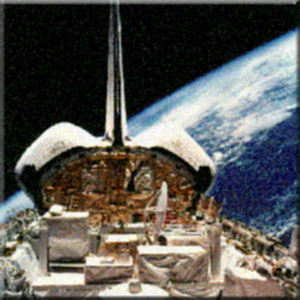|
MAS
Millimeter Wave Atmospheric Sounder
MAS-Principal Investigators (PI's) and Team (1996)
- G.K. Hartmann (PI), Max-Planck-Institut für Sonnensystemforschung (MPS), Germany
- N. Kämpfer (CO-PI), Institut für Angewandte Physik (IAP), Switzerland
- K.F. Künzi (CO-PI), Institut für Umweltphysik (IUP), Germany
- P.R. Schwartz (CO-PI), Naval Research Laboratory (NRL), USA
- G. Schneppe (Management), Deutsche Agentur für Raumfahrtangelegenheiten (DARA), Germany
-
Remark:
Prof. Sir Ian Axford, director of the Max-Planck-Institute for Aeronomy (MPAe ), proposed in 1977 to use the new evolving microwave radiometry spectrometry to investigate the Earth's atmosphere from Space. He was from 1979 to 1983 the principal investigator (PI) of a relevant MPAe experiment which was supposed to fly on the NASA Space Shuttle as the 4th mode of the MRSE experiment from DLR. Due to technical constraints this was not possible and thus the below described experiment ATLAS-MAS was conceived and built.
Abstract
 MAS is a remote sensing instrument for passive sounding of the Earth's
atmosphere from the NASA Space Shuttle. Millimeter-wave radiation emitted
by the atmosphere in the height range between 10 km and 100 km have been
measured at 61, 62, 63, 183, 184, and 204 GHz. MAS yields information about
the altitude profiles of temperature (T), and pressure (P) as well as for
water vapour (H2O), ozone (O3), and chlorine monoxide (ClO) in the
stratosphere, and mesosphere, in the latitude range between +-72 degree for
an orbit inclination of the Shuttle of 57 degree. ClO plays the major role
in the catalytic, anthropogenic ozone destruction.
MAS is a remote sensing instrument for passive sounding of the Earth's
atmosphere from the NASA Space Shuttle. Millimeter-wave radiation emitted
by the atmosphere in the height range between 10 km and 100 km have been
measured at 61, 62, 63, 183, 184, and 204 GHz. MAS yields information about
the altitude profiles of temperature (T), and pressure (P) as well as for
water vapour (H2O), ozone (O3), and chlorine monoxide (ClO) in the
stratosphere, and mesosphere, in the latitude range between +-72 degree for
an orbit inclination of the Shuttle of 57 degree. ClO plays the major role
in the catalytic, anthropogenic ozone destruction.
At the invitation of the US Space Agency, NASA, MAS was successfully flown
as part of
 ATLAS (Atmospheric Laboratory for Applications and Science) mission 1,
(March 24th - April 2nd, 1992) and ATLAS mission 2 (April 8th - April 17th,
1993).
ATLAS 1 and 2 occurred during the flight of the Upper Atmosphere Research
Satellite (UARS), and MAS supplied important correlative data. During ATLAS-3,
which flew from November 3rd till November 14th, 1994, MAS had a failure in
its data processing unit after MAS took 10 hours of excellent atmospheric
data.
ATLAS (Atmospheric Laboratory for Applications and Science) mission 1,
(March 24th - April 2nd, 1992) and ATLAS mission 2 (April 8th - April 17th,
1993).
ATLAS 1 and 2 occurred during the flight of the Upper Atmosphere Research
Satellite (UARS), and MAS supplied important correlative data. During ATLAS-3,
which flew from November 3rd till November 14th, 1994, MAS had a failure in
its data processing unit after MAS took 10 hours of excellent atmospheric
data.
History, Technique, Contributors/participants
The history of MAS goes back to 1978; hardware was built beginning in
1983. MAS was delivered to the Kennedy Space Flight Center in March
1990 for integration into the ATLAS 1 payload.
The observations on board the
Shuttle have been supplemented by measurements of atmospheric
millimeter-wave radiation from the ground and from airplanes in
conjunction with overflights by the Shuttle.
 Some technical data:
Some technical data:
Mass: 200 kg
Power consumption: 406 W
Data rate: 86.4 KBit/s
Antenna (main reflector) aperture: 1.0 m x 1.3 m
Dimensions (LxWxH): 1.28 x 1.34 x 1.73 m
Spectral resolution: 240 channels (12 Bit)
 MAS-Configuration on ATLAS-Pallet
MAS-Configuration on ATLAS-Pallet
Hardware and software contributors in addition to the PI institutes
- Dornier System GmbH; Friedrichshafen; Germany; Prime contractor
- Institut für Datenverarbeitungsanlagen (IDA), der Universität
Braunschweig; Germany
- Physikalisches Institut der Universität Bern;
Switzerland
- Pennsylvania State University (PSU); University Park; PA;
USA
- Physikalisch Technische Studien GmbH (PTS); Freiburg;
Germany
MAS Co-Investigators
- IAP (Institute of Applied Physics, Bern, Switzerland):
Amacher,
W.; Feist, D.
- MPS (Max-Planck-Institut
für Sonnensystemforschung, Katlenburg-Lindau, Germany): Degenhardt, W.;
Hartogh, P.; Loidl, A.; Richards, M.; Umlauft, G.; Vasyliunas, V.;
Jarchow, Ch.
(Further co-workers: Baur, J.; Bierwirth, G.;
Boogaerts, W.; Heise, Ch.)
- NRL (Naval Research Laboratory, Washington, DC, USA):
Aellig, Ch.; Bevilacqua, R.; Daehler, M.; Pauls, T.; Waltman, B.;
Kriebel, D. ( CPI )
- PSU (Pennsylvania State University, University Park, USA)
Croskey, C.; Walter, D.
- ERAU (Embry-Riddle Aeronautical University, Daytona Beach, FL,
USA):
Olivero, J.
- Institut für Geophysik und Meteorologie der Universität
Köln ,Germany:
Ebel,A.
- RAL (Rutherford Appleton Laboratory, Chilton, UK):
Gibbins, C.J.
- ITS/NTIA (Institute for Telecommunication Science, National
Telecommunications and Informations Administration Boulder, Colorado,
USA):
Liebe, H.J., Cotton, M.
- DLR (Deutsche Forschungsanstalt für Luft- und Raumfahrt
e.V., Oberpfaffenhofen, Germany):
Schmidt, E.
- University of Arizona (Tucson, USA):
Twomey, S.A.
- IUP (Institut für Umweltphysik, Universität Bremen,
Germany):
Dicken, H.D.; Wehr, T.; Winkler, A.; von Engeln, A.
(ESTEC)
- NIWA (National Institut of Water & Atmospheric Research
Ltd. Lauder, New Zealand)
Connor, B.
- UM (University of Mendozza / CONICET, Argentinien):
Puliafito, E.
|
|
|
|
|
 |
|
|
|
|
